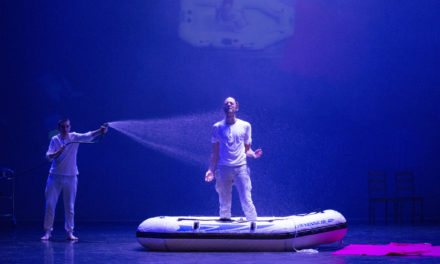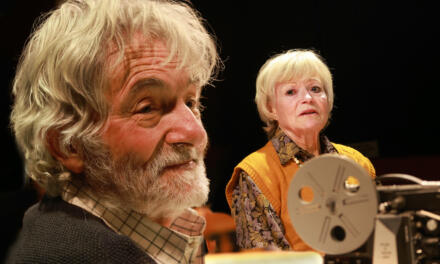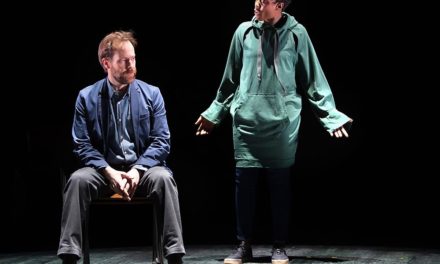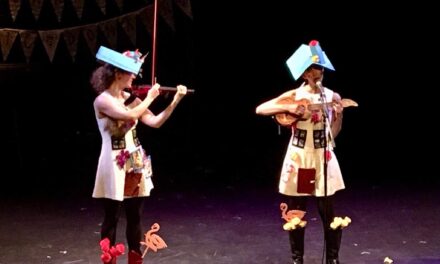A wave of stark white exhibition light washes over me destabilizing every sense, until I catch brief flashes of an exuberant clear blue as it rises and falls within the far distant horizons of my sight. And I am startled by the realization of a stirring, stretching and awaking of deep slumbering memories. As the curved contours and velvet textures of Hannah Clarkson’s sculptures, costumes, installations and works on paper begin to slowly emerge out of this boisterous sea of bright white light, China blue and soft grey, I have the sensation of sinking into the white fluffy clouds and brilliant blue skies that wallpaper childhood memory.
This was the most extraordinarily evocative art exhibition by the artist Hannah Clarkson, a writer, visual artist and a practice-based PhD candidate at the Royal College of Art, London. Clarkson’s particular interest in languages of empathy as embodied in sculpture, costume and performance could not have been more fluently expressed than in the seductive whisperings that emanated from her work, giving the most striking clarity to my sense of presence and the most vivid, vibrant and visceral experience of her work.
Clarkson’s ability to constantly conjure-up virtual worlds that exist side-by-side with the real world, produced an art in a constant state of performance. A performing art that makes the same request of the viewer as a Beckett or Robert Wilson production would make; that you the viewer have to participate in the creation and completion of this work. An active participation in the creation of that world, that paradoxically creates both a distance-provoking formalism and hyper-reflexivity on this process of creation, and an intense sense of immersion into both Clarkson’s actual artistic realm, and the virtual worlds brought into being by the viewer’s memory and imagination.

whole body like gone, image by Annette Balaam, 2023.
Clarkson’s exhibition of new work entitled whole body like gone is inspired by the celebrated theatre designer and Samuel Beckett collaborator Jocelyn Herbert. On the twentieth anniversary of her death Clarkson draws on Herbert’s archive, combining archival images, sketches and anecdotes from the Jocelyn Herbert Collection with her own new sculptures, costumes, installations and works on paper. Complementing the exhibition was a programme of events assessing Herbert’s life and legacy, her work with Samuel Beckett and the broader themes of disability and costume.
Clarkson’s exhibition presents an ‘autoimmune reading of Beckettian absurdism, exploring the themes of care and constraint, exuberance and restraint’. But Clarkson’s autoimmune response to Beckett’s plays Endgame, Happy Days, Not I and Krapp’s Last Tape does not end with one’s own self and body attacking and destroying itself. Rather, like a chrysalis or an oyster – this exhibition moves beyond the discomfort and pain, constraint and restraint of the autoimmune response, to explore the world of beauty, exuberance and life that eventually emerges with the butterfly or luminous pearl.
This simultaneous sense of fragility and strength began as soon as I entered the exhibition space and saw two four-foot-high stainless-steel dustbins, one wearing a pale blue and white lace covered baseball hat and the other a grey and brown patterned old-fashioned bobbled nightcap, immediately evoking the dustbins of Hamm’s parents in Endgame, Nagg’s nightcap, and Nell’s lace cap. The oversized steel dustbins, and the gigantic hat and lace cap shifts my perspective to that of a child looking-up towards distant adults bending-down. And a tableau slowly emerges out of my mind’s eye of a small boy named Hamm permanently searching the far horizons and becoming un-abled.

31 China Bunnies and an Umbrella in Flames, image by Annette Balaam, 2023.
I move on, following the winding path that Clarkson’s colour motif of China blue and grey (Herbert’s favourite colours) forms, and come face-to-face with my favourite piece 31 China Bunnies and an Umbrella in Flames (2023, paper and wood). Clarkson reconstructs Winnie’s mound in Happy Days out of thirty-one papier-mâché China blue and white life-size bunnies. Rising out of the centre of this heap of bunnies is a five-foot tall parasol with a very small, white paper canopy. 31 China Bunnies was inspired by the thirty odd little china rabbits that Billie Whitelaw kept in the mound with her and her props in Happy Days, to, as Sam said, help her ‘recover’ (1993: 222) from Not I. This mesmerizing and extraordinarily joyful sculpture managers to avoid sentimentality, whilst simultaneously singing of the wonder of both the fragility and transience, and strength and permanency embedded in the radiant beauty of the Chinese blue and white porcelain Qinghua, and I see thirty-one rabbits hold the constrained and contained absent-present Winnie with a deep compassion and love.
Drawn further along Clarkson’s blue and grey path I discover Pause for Breath (2023, fabric, swimming rings, coat stand), an exquisitely opulent patchwork coat constructed and textured by the deep and rich fabric of corduroy, tweed, velvet, wool, satin, silk, silver and gilt, shimmering in a multitude of muted hues of blue and grey. Pause is a costume-sculpture constructed out of various different parts: an oriental style coat, and trousers with elastic braces that hold-up four-fabric covered inflated swimming rings sitting on top of each other, snaking around and encircling the lower part of the coat and legs.
Pause seems to both force and offer the opportunity to compare the outer covering of a body to its inner content. In both its physical restrain and artistic freedom, Pause asks the viewer to explore the huge array of physical movement of which the human body is capable, moving beyond any implications embedded in a conventional understanding of Hamm in a wheelchair, Clov’s restrained, difficult, stiff and staggering walk or of Nagg and Nell constrained in dustbins. The hooped baggy trousers and braces and four inflated swimming rings bouncing vigorously and joyously up and down on top of each other suggest the antics of a circus clown, a Buster Keaton or a Laurel and Hardy: a place of hope that sees beyond the hint of tragedy.
Moving further along the blue and grey path I am confronted by the sculpture-costume entitled no better, no worse – no change – no pain (2023, hydroformed steel, fabricated in collaboration with Connor Holland). no better is a headless and handless, full-body costume in which the actor playing Winnie in Happy Days can be entirely encased, with only the hands and top of the head free and visible. Incredibility, the curves, puffiness and pleating forming what appears to be inflated and painted car tyres, are in reality, sheets of welded and pleated steel. But the closer I get to no better, the greater my conviction grows that this is a metallic man. Suddenly childhood fears flood into the hole where the head should be, and I see glaring at me an absent-present army of synchronised, swinging arms attached to evil robots marching straight towards me. But the joyous echoes of Pause’s bouncing rings travels with me. So, stealing closer and closer to no better, my darting eyes quickly confirming that the room is empty of other visitors, I spin round and rap my knuckles hard on its chest to confirm the metallic echo of empty steel. That done – and I hesitate to mention this – I quickly check for visitors again, and then, with a huge grin on my face I stand on my tiptoes and in a loud whisper yodel ‘helloooo!’down the hole where the head should be. I hope this is Clarkson’s ‘hope’ in action. As her programme notes put it, Winnie’s ‘incessantly verbalised hope, like the excessive, exuberant care of an autoimmune body trapped in its own drive to protect itself. This is my version of that absurd play of care and constraint. Armour as amour.’
Passing out of the bright white light through doors into the shadows haunting a high-ceilinged anteroom, I meet the installation entitled all the time the buzzing (2023, upholstered salon chairs). Here, the combination of artificial lighting and daylight created the most wonderful experience of the infinite variety and play of light and shadow waltzing merrily across the floor, doors, walls and ceiling. Two hooded hairdryers hover over two hairdressing salon chairs upholstered in blue and silver leopard skin print, and I almost ‘see’ an imprint in the seats of an absent-present Winnie and Mouth from Not I, and watch as their shadows rest easy. all the time the buzzing interprets the chair that Herbert designed for Mouth in Not I, as Clarkson’s programme notes describe it, as ‘an object of care and constraint. Whitelaw is strapped in and blindfolded, to keep her in place: “My head was clamped in otherwise I’d get the shakes and I would start to quiver.” Yet she is also saturated in the comfort of her choosing, in a cage-chaise constructed for her’.
I strain my ears to pinpoint the source of a soft, confused babbling that I feel is coming from somewhere quite near. Crossing the neighbouring exhibition space to the far right-hand corner, I find that the sound comes from the costume-installation entitled The It-doesn’t-matter-quite-so-much Suit (2023, roofing felt, pearl buttons, boots, voice), a large, glass fronted booth containing an empty suit lounging in a chair. Clarkson takes her inspiration for this reinterpretation of Krapp’s Last Tape from Herbert’s suggestion to Beckett that Krapp could wear ‘a more subdued suit with a hint of faded flair’ rather than the clown-like figure that Beckett initially wrote in the stage directions. As Clarkson explains, her ‘reimagining of the suit is hand-stitched in roofing felt, both protective and abrasive. It is accompanied by a new audio text informed by the looping diary-like form of the play.’
Stalking and hunting this exquisitely lit little chamber, the shadows riffle through and expose a lifetime of memories and hopes of a female voice recording. Skipping backwards and forwards across the years and decades, the thoughts of a multitude of people – Herbert, Whitelaw, Winnie, Mouth, Krapp, Clarkson, coming from a multitude of sources – archival, diaries, letters, plays, autobiographical and the imagination – offer a multitude of narrative threads. I am entranced, and from the open glass doorway I attempt to capture as many complete miniature narratives as possible, from Herbert’s diary “Autumn 1962: Parasol playing up again. Oh, you old extinguisher”, to what I think are Winnie’s, Mouth’s or Krapp’s lines paraphrased, recontextualized, jumping from “Winter 2001” to “Autumn 2023”, back to “Winter 1930” to leap into “Spring 2025”. This huge wave of miniature narratives washes over me, filling the empty grey roofing felt trousers lounging in the chair, giving form to the pearl buttoned roofing jacket hanging on the mustard gold and grey felt, back wall of the cubical, and filling the carelessly strewn white empty boots that follow where the dusty footprints on the floor have been, to seemingly reveal Winnie and Mouth aimlessly wandering along narrow, dusty paths between golden fields shimmering in the dying rays of a late summer sun.
Wimbledon College of Arts, University of the Arts London
5 December 2023
Annette Balaam holds a PhD in modern and contemporary theatre and performance, and Digital and Virtual reality from the University of Bristol. With a particular interest in the work of Samuel Beckett and how his work prefigures our experience in the Digital world.
She has written widely on Beckett’s work and is published in journals, such as: the Theatre Journal, The Theatre Times, International Journal of Performance Art and Digital Media (IJPADM), PARtake, The Beckett Circle and Samuel Beckett Today/Aujourd’hui.
1 Billie Whitelaw cited in Cathy Courtney (ed.), Jocelyn Herbert: A Theatre Workbook (1993). London: Art Books International, p, 222.
This post was written by the author in their personal capacity.The opinions expressed in this article are the author’s own and do not reflect the view of The Theatre Times, their staff or collaborators.
This post was written by Annette Balaam.
The views expressed here belong to the author and do not necessarily reflect our views and opinions.


















